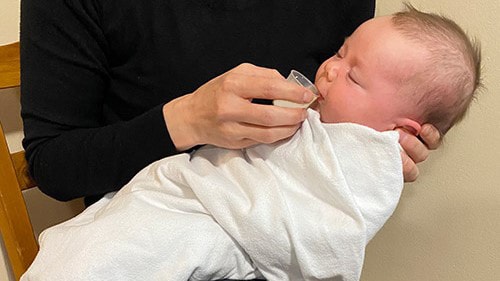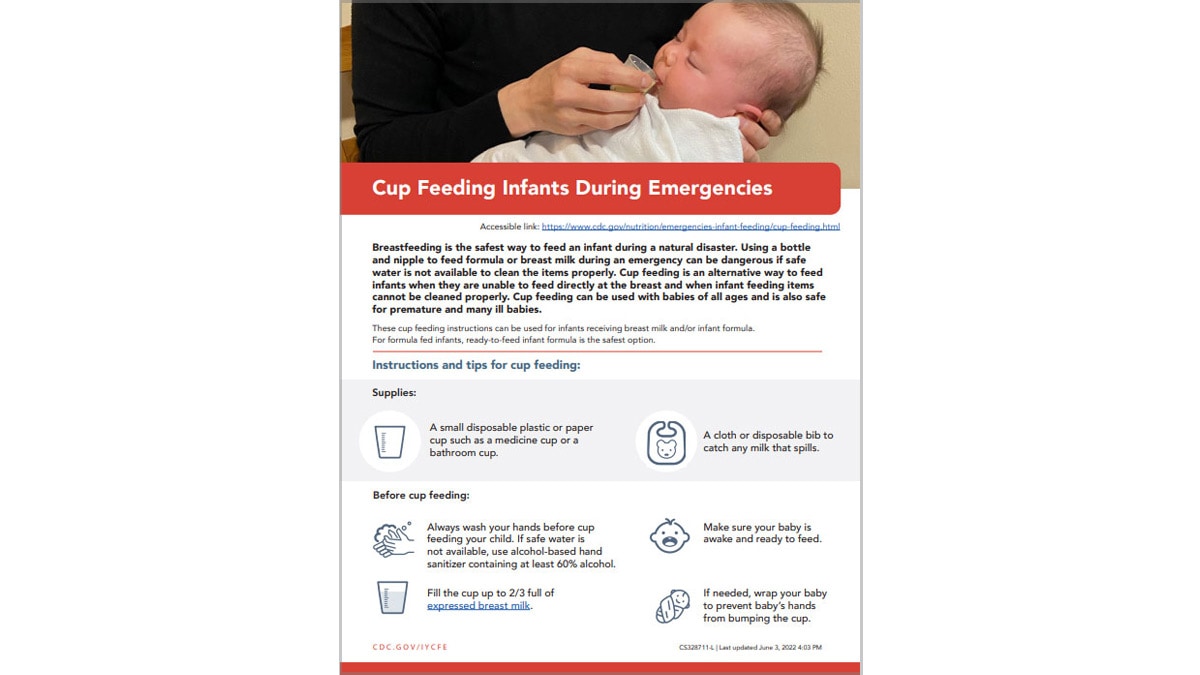What to know
Using a bottle and nipple to feed breast milk or formula during an emergency can be dangerous if safe water is not available to clean the items properly. Breastfeeding is the safest way to feed an infant during a natural disaster. Cup feeding is an alternative way to feed infants when they are unable to feed directly at the breast and when bottle feeding items cannot be cleaned properly.

Instructions and tips for cup feeding
These instructions are for infants receiving breast milk but who cannot feed directly at the breast. Cup feeding can also be used with infants receiving infant formula. For formula-fed infants, ready-to-feed infant formula is the safest option.
Cup feeding can be used with babies of all ages and is also safe for premature and many ill babies.

Before cup feeding
| Always wash your hands before cup feeding your child. If safe water is not available, use alcohol-based hand sanitizer containing at least 60% alcohol. | |
| Make sure your baby is awake and ready to feed. | |
| Fill the cup up to 2/3 full of expressed breast milk. or ready-to-feed infant formula. | |
| If needed, wrap your baby to prevent baby’s hands from bumping the cup. |
Step-by-step cup feeding:
- Hold your baby close to your body in an upright position.
- Use your hand or arm to support your baby's head, neck, and body.
- Hold the rim of the cup to your baby's lower lip.
- Tip the cup slightly so that the milk just touches your baby's lips.
- Your baby will use his or her tongue to lap or sip the milk from the rim of the cup. Do NOT pour the milk into your baby's mouth.
- Go slowly and allow your baby to rest between swallows, but keep the cup touching your baby's lip.
- Keep the cup tipped enough so that the milk stays at the rim of the cup.
- Burp your baby as needed during the feed.
- When your baby has had enough, he or she will refuse to take more. Signs that your baby may be full include:
- Closes mouth.
- Turns head away from the cup.
- Relaxes hands.
- Uses hand motions or makes sounds.
- Closes mouth.
- Discard disposable cup and any leftover milk after feeding. If only a reusable cup is available and there is safe water for cleaning, clean the cup thoroughly with soap and hot water after use and store in a dry, protected area.
- The amount your baby will take depends on your baby’s age. Talk with a health care provider to make sure your baby is getting what he or she needs.
- The amount your baby will take depends on your baby’s age. Talk with a health care provider to make sure your baby is getting what he or she needs.
Adapted from Baby-friendly Hospital Initiative training course for maternity staff: participant's manual. Geneva: World Health Organization and the United Nations Children's Fund (UNICEF), 2020.
